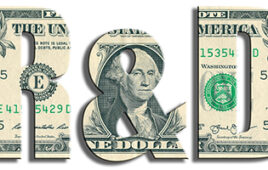
The R&D World Index (RDWI) for the week ending February 12, 2021 closed at 4,544.69 for the 25 companies in the R&D World Index. The Index was up 0.57% (or 25.98 basis points) from the week ending February 5, 2021. The stock of 13 R&D World Index members gained value from 0.30% (Alphabet/Google) to 6.38% (Toyota). The stock of 12 R&D World Index members lost value from -0.52% (Ford Motor) to -3.95% (AbbVie).
A joint study released last week by researchers at the University of Bath in the U.K. and the International Monetary Fund (IMF) that the scientific response to the COVID-19 in clinical trials was seven to 20 times more than the historical relationship would imply. Global pharmaceutical R&D (as measured by clinical trials) increased by 38% to accommodate the COVID-19 response with only a modest reduction in R&D on other diseases, according to the study. Globally, public research institutions accounted for 70% of all COVID-19 clinical trials. Vaccine trials in the U.S. and China were, on average, two months faster than in other countries. Traditionally, market size is an important driver for innovation in pharmaceutical R&D. However, the study concludes that future challenges may require complementing the market size effect with early-stage incentives to harness the power of public research institutions.
Tesla Motors last week announced that it will complete a new R&D center in Shanghai, China, focused on developing a new $25,000 electric car for the Chinese market. The R&D center — the first Tesla R&D facility outside of the U.S. — is located in the Tesla Lingang Gigafactory. The R&D center is expected to be completed by mid-2021. The new EV is expected to have a range of more than 200 miles. Tesla also stated that it will build a new production facility by the end of 2021 in Karnataka, India.
Tesla has owned the EV market for many years, but the company will face increasing competition in 2021. Other automakers who have committed to introducing 100% electric vehicles in Spring-to-Fall 2021 include Hyundai (Ioniq 5), Nissan (Ariya), GMC (Hummer), Volkswagen (ID.4), Ford (Mustang Mach-E), Lucid (Air), Rivian (R1T and R1S), Lordstown (Endurance), Audi (R-Tron GT), Toyota (2 unnamed models) and Mercedes-Benz (EQS). Ford and Volkswagen were hit with a court ruling last week against their battery-supplier SK Innovation (SKI) which could disrupt some of the automakers’ production plans by limiting their long-term supply of batteries. Despite a 10-year ban, SKI is still allowed to supply batteries for the next two years to Ford and VW. Battery competitor LG Chem won the law suit against SKI citing theft of trade secrets.
The semiconductor chip shortage discussed in previous RDWI newsletters is likely to become exacerbated with the increased EV production noted above and the upcoming autonomous vehicle introductions (by 2024 to 2025). Research group HIS Market Ltd. has estimated the current automaker-wide chip shortage will result in nearly 700,000 fewer cars than planned for in 1Q 2021. Automakers have furloughed tens of thousands of workers globally as a result of the chip shortage. GM has expanded downtime, for example, at its plants in the U.S., Canada and Mexico. The company expects to see about $2 billion in lost revenue as a result in 2021.
Social media company Twitter last week announced that it expects to ramp up spending in 2021 in engineering and R&D. With 2020 revenues increasing by more than 20% to nearly $4 billion, the company expects to grow its workforce by 20% in 2021 in engineering, product design and research.
The U.K.’s GDP shrank by 9.9% in 2020, the largest slump in more than 300 years (since a 13% drop from the Great Frost of 1709), despite seeing a 4% increase in 4Q 2020, according to the U.K.’s Office for National Statistics last week. This was the largest annual decline among the Group of Seven’s advanced economies. By comparison, the U.S. economy shrank by about 3.5% for the year, and Germany’s GDP declined by 5%. The U.K. economy (and its R&D spending) are also under stress from the COVID-19 pandemic variants and Brexit effects, which are currently increasing in severity.
China’s centrally administered state-owned enterprises increased spending on R&D by 11.3% in 2020, according to China’s state-asset regulator. China’s R&D intensity of central industrial enterprises (COEs) was 3% for 2020. Revenue from these COEs, however, decreased by 1.9% in 2020, according to China’s Ministry of Finance.
RDWI-member AstraZeneca announced last week that it was fixing problems with its COVID-19 vaccine production and expects to double monthly production to approximately 200 million doses by April. AstraZeneca and its technology development partner the University of Oxford are also working on new versions of their vaccines to target existing and emerging variants of the coronavirus. They expect to produce adapted vaccines within six to nine months using clinical trial data and manufacturing data already in place. The World Health Organization (WHO) last week recommended the AstraZeneca vaccine for broad global use, including countries battling the emerging variants. South Africa temporarily halted use of the AstraZeneca vaccine, citing clinical results which were too small against the new fast spreading strains. South Africa instead plans to accelerate deployment of the new Johnson & Johnson vaccine.
About the R&D World Index
R&D World’s R&D Index is a weekly stock market summary of the top international companies involved in R&D. The top 25 industrial R&D spenders in 2019 were selected based on the latest listings from Schonfeld & Associates’ June 2020 R&D Ratios & Budgets. These 25 companies include pharmaceutical (10 companies), automotive (6 companies) and ICT (9 companies) who invested a cumulative total of nearly 260 billion dollars in R&D in 2019, or approximately 10% of all the R&D spent in the world by government, industries and academia combined, according to R&D World’s 2021 Global R&D Funding Forecast. The stock prices used in the R&D World Index are tabulated from NASDAQ. NYSE, and OTC common stock prices for the companies selected at the close of stock trading business on the Friday preceding the online publication of the R&D World Index.



Tell Us What You Think!